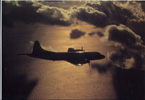mdiehl
Posts: 5998
Joined: 10/21/2000
Status: offline

|
quote:
At the risk of opening up a debate I do not have time for, the loss figures at Guadalcanal are a poor basis for rating relative performance of the two aircraft in early 1942. The problem with the historical exchange rate is that the battles between F4F's and Zeros occurred over Guadalacanal in late 42. Allied fighters enjoyed significant advantages in those engagements:
Well, they enjoyed some advantages. One problem with this line of reasoning is, however, the consistent willingness to list Allied positional avantages without considering the numerous Japanese advantages.
The US aircraft had the most crude and ill-supplied maintenance facility that was under chronic threat of ground attack, artillery bombardment, and naval shelling. This is to be contrasted with the Japanese base at Rabaul, which was comparatively well supplied and where the aircraft could be maintained without substantial immediate threat and free of sustained, chronic threat.
The airfields at Guadalcanal had the most crude airstrips made of dusty crushed coral that greatly increased wear and tear on the US engines. This is in contrast with the airfields at Rabaul.
The US pilots on Guadalcanal were likewise subject to round the clock combat. After flying a mission they could land on an airfield (subject to taking ground fire on approach), be fed inadequate food, and be the target of snipers, artillery, and naval bombardment, all of which greatly increased US pilot fatigue. Japanese pilots, in contrast, knew that once they were clear of the combat area around Guadalcanal, they were essentially free from immediate threat.
quote:
Zero pilots were escorting, which tied them to the bombers and limited the flexibilty with which they could fight.
Unfortunately this does not necessarily merit the status of an "American advantage." The Zeros best days in the Guadalcanal campaign occurred when they were escorting bombers. The Zeros worst catastrophe was when they attempted a "fighter sweep" effort and were soundly defeated. I'm not sure what conclusions one may draw except that depending on how escort missions are handled it can be as challenging for the interceptor who has to fly a dual mission (evade the enemy fighters, close with enemy bombers).
quote:
Zeros were at long range, even for a Zero, flying from Rabaul to Guadalcanal placed the Zero at the limit of it's range and placed severe limitations upon Zeros in terms of ability to operate at full or emegency power.
Zeros had about 10 minutes of air combat time at full power over Guadalcanal. This would be accurately called an American advantage except of course that most air to air combats lasted less than three minutes. I suspect that the only real penalty here to the Japanese was in the "unexplained loss" of Zeros seen leaving the combat area that never returned to base. A very small percentage of Japanese zeros were lost under these unexplained circumstances. Most of them were shot down directly.
quote:
IJN pilot quality had taken a blow at Midway and the quality of the pilots flying at Guadalacanal had declined.
Not really. The IJN pilot pool at Midway was not terribly depleted (see Tulley and Parshall's Shattered Sword). Most of them survived albeit without their aircraft. In any case Midway would not matter for the Guadalcanal campaign, because none of the Midway air groups were assigned to the campaign. Instead it was the Tainan air group (initially) and a couple others, who represented (arguably) the best pilots that the Japanese had available.
Japanese pilot quality deteriorated largely BECAUSE of the Guadalcanal campaign, not prior to that campaign.
Another problem with viewing the Guadalcanal campaign results as atypically "bad" for the Japanese is that the Guadalcanal results were actually the high point of Zero performance vs Wildcats in WW2. In ALL previous campaigns (Midway, Coral Sea, and Midway VMF component), where the Japanese had no disadvantages vis a vis range and air time, and where they were often flying defensive CAP (with American fighters acting as bombing escorts) in direct head to head encounters between F4Fs and A6Ms, the F4Fs achieved about a 1.5:1 favorable kill ratio.
Repeat: At ranges that represented the comfortable window for A6Ms and long ranges for F4Fs, where F4Fs flew bomber escort, they shot down about 1.5 Zeroes for every F4F lost. That the F4F drivers emerged victorious on ground manifestly favorable to the Japanese obviates any claim that Japanese defeats in A2A only occurred where operational circumstances favored the Allies.
quote:
Despite the above tactical disadvantages, the pilots in teh Zeros achieved near parity for the first stages of the Battle for Guadalcanal. In light of that, suggesting that all engagements should follow the same lines is ludicrous to me.
Actually, in the Guadalcanal campaign, they largely beat the USN/USMC pilots. About a 1.1-1.2:1 kill ratio vs F4Fs. I attrbute this to the severe logistical, maintenance, fuel supply, and sleep-loss handicaps affecting Allied pilots.
quote:
Finally, the myth of superior deflection shooting training is just that, a myth.
That is incorrect. If you read Lundstrom's The First Team at Guadalcanal you will note that he and others, including USN and USMC pilots of the time, note that Japanese pilots were generally poor at deflection shooting while USN and USMC doctrine and training in deflecton shooting was substantial. Many of Japan's best pilots were killed because they would make a firing pass at an F4F and zoom climb in front of the F4F in order to lure it into an energy burning turning engagement. Often that was the last maneuver that the Zero pilot lived to attempt.
quote:
If you read Saburo Sakai's biography, you will note that he talks about the poor markesmanship of Allied pilots. As late as 1944, a battle between him in a lowly Zero and a bunch (8? 10? I forget) of Hellcats resulted in no bullets hitting his aircraft despite the fact he was disadvantaged by overwhelming odds and being blinded in one eye!
Sakai had no expertise either on US deflection shooting training nor doctrine. Beyond that, much of what he claims occurred is quiet subject to doubt. If you are referring to Martin Caiden's tome, it is scarcely better than fiction, since many of the events in that book are events that Sakai subsequently and flatly stated never happened.
I think you have to view Sakai's perspective in light of the noble lost cause mentality that permeates much of the Japanese historial perspective from 1950-1990. Moreover, you should view Sakai's point of view as rather atypical, because the typical Japanese pilot discovered, to his mortal cost, that Allied gunnery was very good.
< Message edited by mdiehl -- 6/17/2006 2:21:25 AM >
_____________________________
Show me a fellow who rejects statistical analysis a priori and I'll show you a fellow who has no knowledge of statistics.
Didn't we have this conversation already?
|
 Printable Version
Printable Version


















 New Messages
New Messages No New Messages
No New Messages Hot Topic w/ New Messages
Hot Topic w/ New Messages Hot Topic w/o New Messages
Hot Topic w/o New Messages Locked w/ New Messages
Locked w/ New Messages Locked w/o New Messages
Locked w/o New Messages Post New Thread
Post New Thread